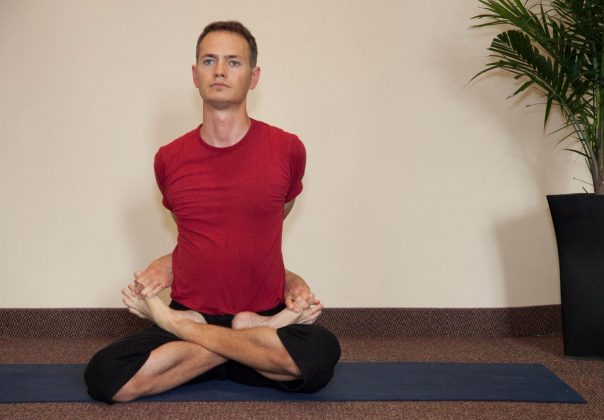Teaching Yoga to Protect the Knees
It is not uncommon to hear about former Yoga students, who dismiss the practice, due to the knee pain they experienced during a complex pose. At the same time, it is not uncommon to encounter devoted students, who point to Yoga practice as a therapy and practical cure for the knee pain they once experienced, prior to beginning practice. As a result of these two conflicting ideas, people might wonder what is the truth.
Just like anything in life, the truth about Yoga, and knees, is both simple and complex. It is simply true that some Yoga asanas (postures) place strain on the knees, and that incorrect form can lead to knee pain or injury. It is also true that good therapeutic Yoga sessions can effectively end years of knee pain and debilitation Baddha Padmasana precautions.
This is where the complexity comes in: Practicing Yoga correctly can be difficult for many students because poses are often complex and challenging. Padmasana (lotus pose) looks easy enough, but an adult from a chair-sitting culture may cause harm to the knees or hips by trying to get into the posture. For this reason, new Yoga instructors should be aware that students would be better off working with Ardha Padmasana (half lotus posture) as a warm-up to Padmasana. It is possible for a student to attempt Padmasana for life and not be able to master this posture. Rather than frustrate our students, half lotus or Sukasana (easy posture) are viable options Baddha Padmasana wikipedia.
How Does Yoga Protect Knees?
Knee injuries occur under a variety of circumstances. Often, knee pain is a result of torn or strained ligaments or of a worn down meniscus, which is the cartilage within the knees meant to provide padding and cushion during movement and impact activity. Knee pain can also be caused by osteoarthritis in the knee or by misalignment of the kneecap.
In many cases, these knee injuries are related to a sudden injury (auto accidents, sports-related injuries, etc.) or a muscular imbalance. In the case of a muscular imbalance, quadriceps that, in their strength, over-compensate for weaker hamstrings, can cause an over-rotation of the knee, which results, over time, in pain and higher risk for tears, sprains, and osteoarthritis.
Therapeutic Yoga protects the knees by strengthening the knee and bringing stabilizer muscles in balance with each other, which aids in correct knee alignment and a more equal muscle strength distribution.
Tips for Teaching Yoga to Protect the Knees
1. In order to avoid the risk of knee injury inherent in some poses, a Yoga instructor must emphasize that students not force themselves into high risk poses that strain the knee. Often, these poses require flexibility that takes time to acquire, and students need to be reminded that this is a practice in patience and mastery rather than quick progression.
2. Yoga students, recovering from knee injuries, should also avoid quick transitions from pose to pose, as more abrupt movements, especially in complicated poses, can cause injury.
3. Yoga teachers should emphasize that some stretching sensations are necessary to improve flexibility, but practitioners should back off if knee pain flares up, regardless of the perceived level of expertise.
4. Legs should be thoroughly warmed up and stretched before a student launches into a pose, such as Padmasana, which can put pressure on the knee. Yoga instructors should consider modifying poses for students with persistent knee pain, ailments, or injuries.


Comments
Post a Comment